To kick off the upcoming football season, I am pleased to share a significant acquisition in my ongoing Jack Trice research. For the first time ever, I am proud to present the only original picture of Iowa State legend Jack Trice in a football game. This is a new image of the Ames vs. Simpson game nearly 91 years ago, which was the first varsity game for Jack. The picture has never been seen in public before.
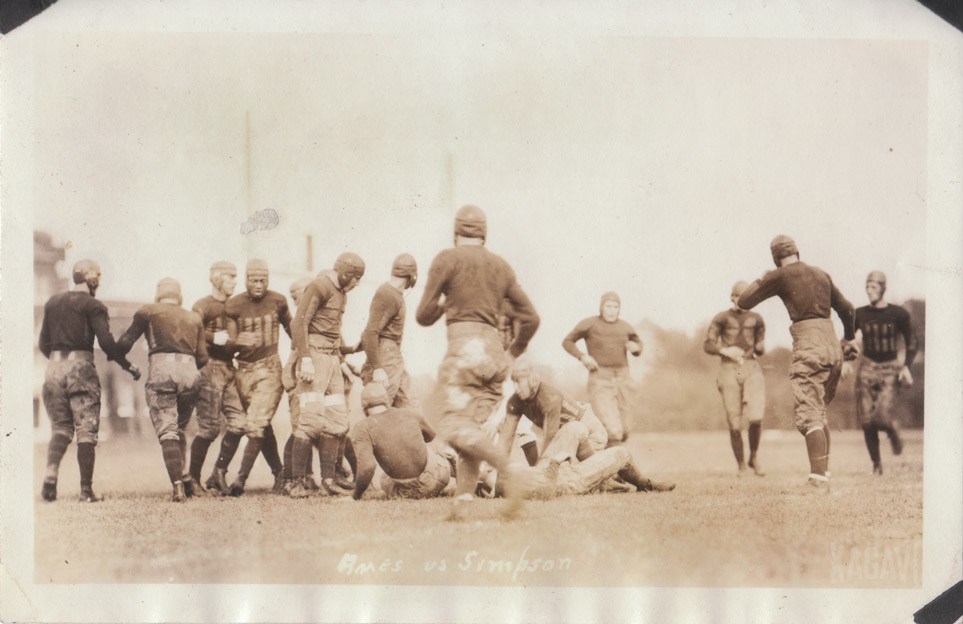
_____________
Part of Jack’s mystique as Iowa State’s first Black football player comes from the sheer lack of personal effects left behind. As a poor Black man during an overtly racist era, any photo of him is incredibly rare. Teammates pointed out how Jack was one of the very few Blacks in Ames and he was used to blending in and “knowing his place.” The only collegiate pictures of him that exist are from the spring football game in 1923 when each member of the team was photographed. There is one additional picture of him as a Cyclone in the freshman team portrait a year earlier.
Last year, I shared a discovery of Jack’s blurry face hiding in the shadows of a yearbook photo from the Simpson game. At that time, it was the only picture of Jack Trice in action–albeit very small. Subsequent research revealed two more rare pictures of him as a high school freshman in Cleveland and in the first ever picture of the historically black Alpha Phi Alpha fraternity’s new Des Moines chapter.
During Jack’s time in Iowa, the small, loyal Cyclone following was dwarfed by the fan support of other powerhouse schools in the Midwest. When schools such as Iowa, Nebraska, and Minnesota enjoyed breakout seasons, the surge in school pride led to far more fans preserving memorabilia and images in scrapbooks. Despite a small blip of success in the mid-teens, the Ames football program often had more in common with the smaller local colleges such as Simpson, Grinnell, and Drake. With less fans, reporters, and photographers, the opportunities to capture Cyclone moments were exponentially decreased.
In the early 1920s, as America emerged from the costly first World War, the popularity of college football exploded. The increased interest in the sport also allowed professional football to finally take hold with the formation of the NFL in summer 1920. Schools started building huge new stadiums memorializing the war dead while Iowa State’s plans for a renovated horseshoe stadium were drastically downsized.
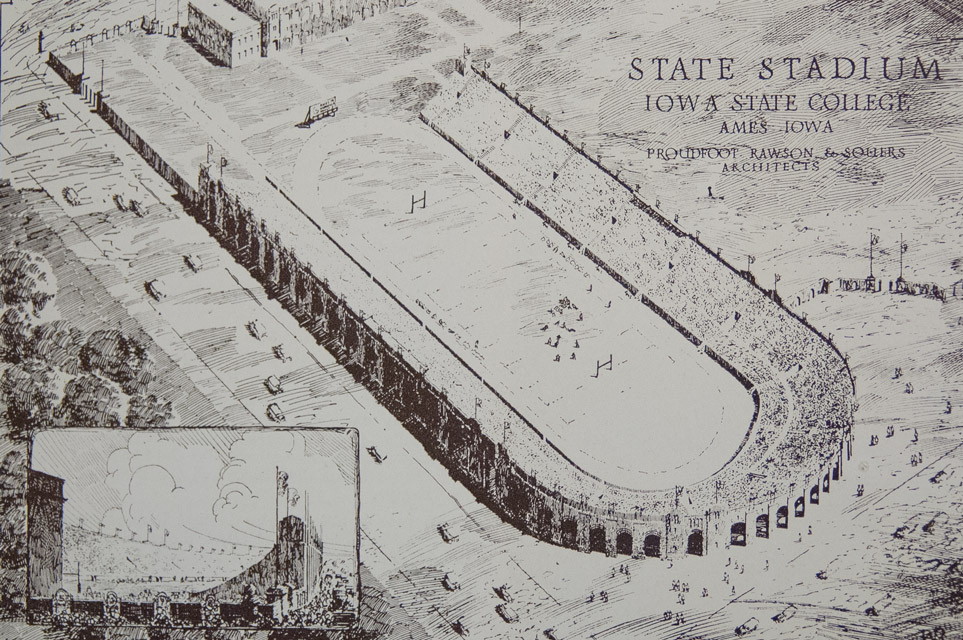
In 1922, the Iowa State College brass made a bold move by hiring former Ohio State star Sam Willaman away from East Tech High School in Cleveland where he coached Jack Trice, the Behm brothers, and other future Cyclones to consecutive undefeated seasons including a birth in the mythical high school national championship game. In Ames, while many of his future stars languished on the freshman team, Coach Willaman looked forward to the 1923 season when they would finally be eligible.
Due to rules prohibiting collegiate freshman from competing on the varsity squad, Jack and his fellow East Tech teammates had to settle for scrimmages against the varsity squad. Led by Jack and the Behm brothers, the younger players often beat the older players and left the Cyclone coaches salivating at the possibilities to come. In the lead up to the 1923 season, as players trickled back into Ames over the summer, Jack brought a surprise: a young bride named Cora Mae. It had been a long 22 months since Jack’s last meaningful football game and the future was finally here.
With an eye towards the powerful Minnesota squad the following week, Coach Willaman hoped to use the Simpson game on September 29 to break in his young stars. Jack’s talent was already so evident, leading up to the game, the Ames Daily Tribune noted “Trice, the big Negro tackle, was in every play, and indications are that opposing coaches will have a serious problem closing the holes the big fellow is sure to open.” Willaman kept his playbook buttoned up and used the Simpson game as a live audition for the right guard position next to Jack. Fellow linemen Thorburg, Berger, and Larson all took turns throughout the close game. Jack’s strong performance against Simpson’s captain–a brawny left tackle named Meeks–made it clear the Gophers would have a battle awaiting them.
_____________
Before we dive into further analysis of what’s within the picture, let’s take another closer look at the main scrum that Jack is emerging out of. It is difficult to say whether Ames is on offense or defense, but based upon the positioning of the players, it appears as if Simpson is facing the goal line on the north side of the field near State Gym. Keep in mind, the game moved much faster during that era. No one lingered on the ground and it’s clear the players are getting ready to line up again immediately. Given Jack’s position of right tackle and his position in the picture, it also supports Simpson facing the end zone.
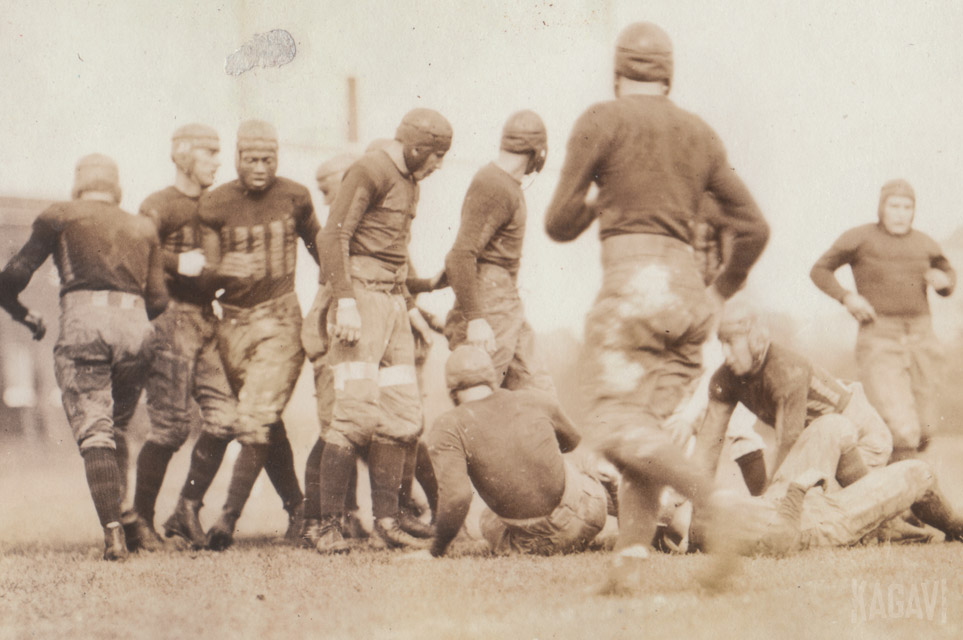
There’s lots to unpack here. The picture itself is just 4″ x 6″ but scanning it allowed me to tease out additional details. Immediately apparent is Jack’s jersey design, which is different from the famous spring game photos. My previous story, “The enigma of Jack Trice’s gold jersey” has more about this jersey change. These temporary jerseys were quickly replaced by Coach Willaman’s gold jersey design, which was touted as a lighter jersey and debuted in Iowa State’s inaugural spring game in early 1923, where they were immortalized in photos.
During game week, the Simpson team notified Coach Willaman they would be bringing their gold jerseys to the game, so Willaman had to pull out some cardinal jerseys from the previous season that were never worn in a game. The lack of visible rear numbers on the Cyclone players here has solidified my strong suspicion that these temporary jerseys were never worn in a game in 1922, despite being pictured in the player portraits. If they had, one would think gold numbers would already be stitched on the jerseys. (Earlier in the week, the Iowa State Student reminded fans the football jerseys had “for years been cardinal with gold numeral.”)
Despite the unexpected change back to the cardinal jerseys for the Simpson game, the Iowa State Student reassured readers the day before the game: “those who have learned the players, by numbers need not be disappointed, as each man will wear his number in good sized letters on his head gear.” Since the gold jerseys were worn in the spring game, fans probably had an opportunity to start learning players by their numbers. Upon viewing all pictures, I strongly suspect these cardinal jerseys had leather friction strips in contrast to the canvas material used in the gold jerseys, which would also support reports that the gold jerseys were lighter.
Thanks to the sharpness of this picture, by zooming in, we were able to see how that appeared for the first time ever. The furthest left person is wearing a helmet with the number 12 painted on the ear flap. A look at the game program that we unearthed last year reveals this player as Bill George, the starting left half back.
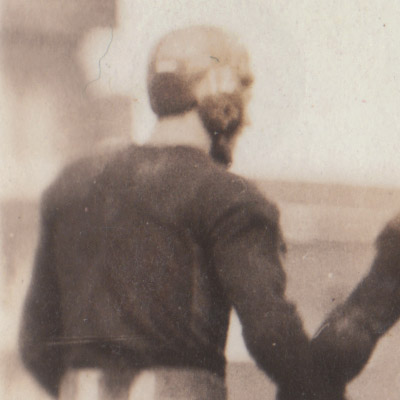
Behind Jack is another player with a harder to read number. It’s clearly two numbers and appears to start with either a two or three. According to the game reports, only 16 Cyclone players saw action and five had a number between 20 – 39 (Trice excluded). Further research will be needed to accurately identify this player.
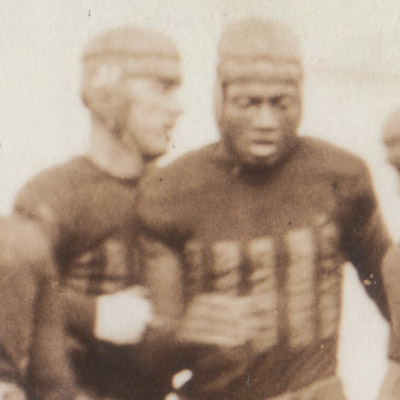
If we succeed in naming that player, with enough time and some luck maybe we could figure out the specific play pictured here, especially considering Bill George was substituted in a couple of times at various points in the game. Jack blocked a field goal try near the end zone in the first quarter. Was that play around the time of this picture?
This is also the first picture of Jack to show him wearing a helmet. We can reasonably assume his helmet would’ve had 37 written just above the ear hole, corresponding with the Simpson program. In time, given this clear image of Jack, maybe we could figure out what exact helmet model he wore. Presumably the numbers lingered on the helmets through the Minnesota game, but a look at the Minnesota pictures gives inconclusive evidence. If we find any new Minnesota game pictures, this could come in handy.
Elsewhere in the picture, the person jogging away from the camera at center appears to have number 17 on their jersey, which would correspond to Simpson’s left end Faucett, which makes sense given the context of the field. Laying on the ground near Jack is another Simpson player with a barely discernible number that could be 32, which would be Simpson’s left half back McCoy. Three Simpson linemen had numbers in the thirties as well. I found it interesting how closely the Simpson numbers appear to match their jersey, but that doesn’t necessarily mean their numbers were gold on gold. Just another small mystery to consider.
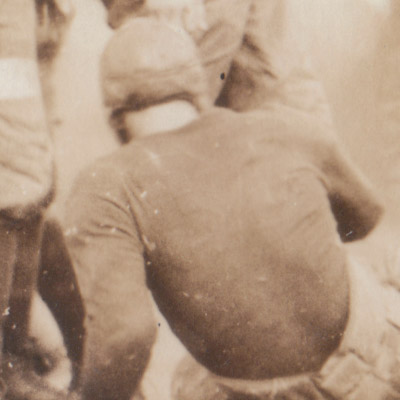
_____________
These kinds of pictures are incredibly important in creating a tableau of what Jack’s actual experiences were at Iowa State. Remarkably, this is the only picture that shows Jack in the midst of his life and not merely posed in front of a camera. The first time I saw the picture, a jolt ran through me and during the writing of this story, I often enlarged the picture to slip into the picture just in time to see the play unfold in front of me. I could almost feel the fall breeze.
The picture was part of a collection that I acquired from a long-time fan of football in the Midwest, which I will share more about another time. For our next Jack Trice story, I will share my latest impossible quest: an attempt to find any trace of Jack Trice’s actual Iowa State jersey.
